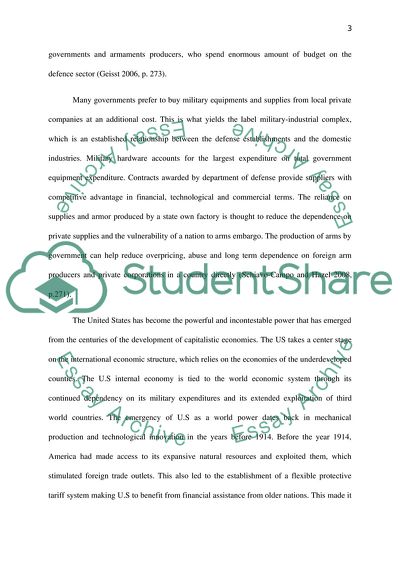Cite this document
(Military Industrial Complex Essay Example | Topics and Well Written Essays - 2500 words - 1, n.d.)
Military Industrial Complex Essay Example | Topics and Well Written Essays - 2500 words - 1. https://studentshare.org/military/1791893-is-the-military-industrial-complex-a-result-of-the-reliance-of-the-capitalist-economy-on-military-production-as-a-stabiliser-of-the-economy-or-is-it-a-result-of-the-projection-of-power-against-challenges
Military Industrial Complex Essay Example | Topics and Well Written Essays - 2500 words - 1. https://studentshare.org/military/1791893-is-the-military-industrial-complex-a-result-of-the-reliance-of-the-capitalist-economy-on-military-production-as-a-stabiliser-of-the-economy-or-is-it-a-result-of-the-projection-of-power-against-challenges
(Military Industrial Complex Essay Example | Topics and Well Written Essays - 2500 Words - 1)
Military Industrial Complex Essay Example | Topics and Well Written Essays - 2500 Words - 1. https://studentshare.org/military/1791893-is-the-military-industrial-complex-a-result-of-the-reliance-of-the-capitalist-economy-on-military-production-as-a-stabiliser-of-the-economy-or-is-it-a-result-of-the-projection-of-power-against-challenges.
Military Industrial Complex Essay Example | Topics and Well Written Essays - 2500 Words - 1. https://studentshare.org/military/1791893-is-the-military-industrial-complex-a-result-of-the-reliance-of-the-capitalist-economy-on-military-production-as-a-stabiliser-of-the-economy-or-is-it-a-result-of-the-projection-of-power-against-challenges.
“Military Industrial Complex Essay Example | Topics and Well Written Essays - 2500 Words - 1”. https://studentshare.org/military/1791893-is-the-military-industrial-complex-a-result-of-the-reliance-of-the-capitalist-economy-on-military-production-as-a-stabiliser-of-the-economy-or-is-it-a-result-of-the-projection-of-power-against-challenges.


